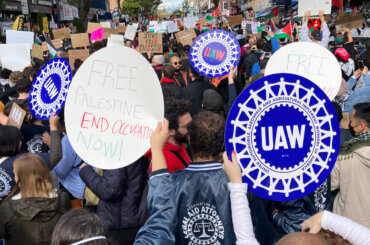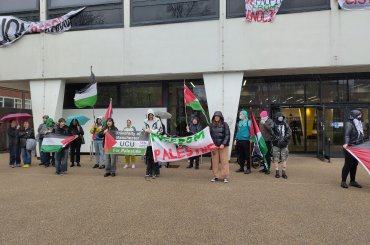On June 3, activists in the Boston-area released the Mapping Project, a project created to “investigate local links between entities responsible for the colonization of Palestine, for colonialism and dispossession here where we live, and for the economy of imperialism and war.” Below is an interview with key members of the project to discuss the origins of the mapping project, how to use it, and key lessons learned, and also be sure to read “Zionism, Policing and Empire: A Dispatch from the Mapping Project” which continues to unpack the project’s findings.
What is the Mapping Project? Who is behind the effort, what was the initial idea, and how did it all come together?
The Mapping Project is an effort to build a deep base of knowledge about Boston-area corporations, institutions, and other entities that are sustaining the colonization of Palestine, US imperialism, policing, displacement, and other interlocking systems of oppression. Through the map, we aim to help local movements identify strategic vulnerabilities of existing systems of power and imperial violence, in order to effectively weaken and dismantle them. The Mapping Project also aims to deepen our movements’ collective political analysis as well as our relationships with each other as we continue to struggle, research, learn, and discuss together by developing the map.
We are a collective of activists and organizers involved in anti-imperialist and Palestine solidarity struggles, who came together around a shared desire to develop a stronger understanding of the oppressive entities we’re up against, how exactly they work, and the institutional structures that sustain them.
The Mapping Project arose through conversations we’ve been having over the years about the limitations of Boycott, Divestment, and Sanctions (BDS) efforts which focus upon one corporation or institution at a time, often demanding that an entity act “more ethically” by ending one contract or partnership with Israel without accounting for the breadth of its support for zionism and other interlocking systems of oppression – e.g., appealing to Amazon to end its participation in Project Nimbus, without addressing the the breadth of Amazon’s support for racism and violence in Palestine, the US and elsewhere in the world, and its role in the broader system of racial capitalism. Moreover, we felt that BDS efforts often missed the full picture of how the corporations, institutions, and other entities sustaining zionism and other oppressions operate: not in isolation from one another, but through the web of connections they establish with one another to more effectively carry out their oppressive agendas – e.g., Raytheon establishing research centers at MIT (while Boeing leases space from MIT); or the Brookline Police coordinating with the Consulate General of Israel to New England to repress a Palestinian-led protest.
The amount of information is a bit overwhelming to take in. So a few questions in this regard. First, what would you suggest is the best way to use the map?
The map is an organizing tool. It is best used as a source of information to develop strategy for fighting back against zionism, US Imperialism, and other interlocking systems of oppression. Suppose you are a Boston area university student and the Israel-linked weapons developer General Dynamics is scheduled to come onto your campus to try to recruit your classmates to make their products of death and destruction: Use our map as a rapid source of intel, not only on the violence General Dynamics perpetrates worldwide, but also on the nefarious links General Dynamics maintains with entities here in Massachusetts. And then, armed with this knowledge, organize your classmates to shut them down.
The map provides a place for organizers to share information on local oppressors now, but also historical information on these same oppressors that can be lost from generation to generation. The process of building this map connected us to multiple generations of organizers and local organizing history that has impacted how we think about our political work.
What is the story this map is telling us? Or, what are the main takeaways you would like a user to come away with?
There isn’t only one story the map tells. It tells many intersecting stories. The map tells the story of universities in Cambridge and Boston that gobble up land and lease it out to weapons developers and computing, biotech, and pharma companies that drive up rents and property values, and thereby fuel the displacement of longtime working-class residents (who can no longer afford to live in the communities they have called home for decades). The map tells the story of police forces across Massachusetts that are both highly militarized and remarkably integrated with one another as well as with the Department of Homeland Security, local universities, and zionist NGOs like the Anti-Defamation League. The map tells the story of powerful donor advised funds and private philanthropic foundations that are quietly funneling billions of dollars every year into organizations which help carry out and normalize Israel’s colonization of Palestinian land and theft of Palestinian resources.
One simple takeaway from the map is this: the companies and institutions sustaining Israel’s colonization of Palestine are the same companies and institutions sustaining policing, supporting ICE deportations, profiting from US wars, and driving evictions and displacement.
However, one simple takeaway from the map is this: the companies and institutions sustaining Israel’s colonization of Palestine are the same companies and institutions sustaining policing, supporting ICE deportations, profiting from US wars, and driving evictions and displacement. And they do all of this together, through a web of partnerships and collaborations.
Although at first glance the map might seem overwhelming, it actually reveals that US imperialism isn’t an abstraction, or something that happens far away, but a concrete project that’s being advanced right where we live, by entities that have physical addresses. There is simply no way to protect so many nodes of oppression from a movement that is determined to interfere with them. We hope this recognition will stimulate creative action. We also hope that we can build more power to dismantle these systems by seeing how our struggles our connected – because we’re fighting the same oppressors – rather than working in silos.
Was there anything that surprised you as this project came together?
One thing that jumped out at us is that there are “super-oppressor” entities that connect the overtly repressive forces – police, FBI, military, weapons developers – with the less overtly repressive world of non-profits and foundations (what INCITE! collective calls the “non-profit industrial complex”). These super-oppressors include major universities and institutions like the Harvard Kennedy School, as well as foundations like Klarman Foundation, CJP, and the Gann Foundation and organizations such as the ADL. These entities have tremendous influence: they buy legitimacy in the world of “soft” power by shaping narratives and dictating policy, but they also directly ally with society’s most violent institutions (the ADL, for example, is connected to virtually every police force in Massachusetts).
We also found that a commitment to US imperialism permeates through many of the area’s entities. Boston’s biomedical-pharma powers, which contribute to perpetuating medical and vaccine apartheid around the world – in Palestine, South Africa, and India – and to keeping medicine unaffordable here, are also heavily funded by the Pentagon, and some are involved in the weaponization of biology. Those same entities also engage in “internal colonialism” here: they take over land and displace Boston’s working-class communities, especially BIPOC communities. So those who participate in colonial projects abroad tend to do so at “home.”
We also noticed that even seemingly minor entities contribute to multiple oppressions around the world. For instance, the same construction and architecture firms that build local university campuses and labs for big pharma also build local prisons and government weapons labs – as well as army bases in colonized Palestine.
All this shows that our struggles are truly connected, around the world.
What do you hope this project adds to the Palestine movement and other movements it relates to?
We hope the Mapping Project helps organizers in the Boston area (ourselves included) understand this fuller picture of the local forces that support and sustain racism here, zionism, US imperialism, and other entwined systems of oppression. We hope that, with this fuller picture, organizers can plan ways to disrupt these systems and one day dismantle them altogether.
Are there plans for the future? How do you plan to build out this Boston-area project, and are there thoughts to create similar maps for other localities?
This is just the first iteration of the Mapping Project. We hope to continue to grow the project through building relationships with other local organizers, and to keep updating the map. Now that the project is public we hope like-minded organizers can find us.
While we ourselves do not intend to create a similar map for another place (our map focuses on Boston/Cambridge because we live here), we would be excited to hear from organizers who want to do something similar in their own area. This project was a huge amount of work, and it required developing our own software for collectively writing, organizing, and visualizing this research. We would be happy to share our tools and what we’ve learned with organizers who are similarly committed to dismantling these oppressive systems.



I read about the “mapping eproject” elsewhere, but am not surprised that a search led to the intellectual outhouse that is mondoweiss. Weiss’ one-note-samba of logorrheic drivel always makes my hair hurt. These are the Proud Boys of the idiot left, who have wasted their parents’ investment in expensive colleges, so divorced are they from ability to discriminate. That there are enough actual sympathizers to keep them afloat has always amazed me. Or maybe they all have trust funds.
What a joke. Draw colored dots and lines to most every small time police department in Massachusetts, as if their mere existence is a problem for the Palestinians. And for some reason little old Webster (pop:17,000) and Norton (pop:20,000) seems to be nexuses for all this evil.
Looking for the overlap of jew hatred and antizionism? You found it. And praised it. The Mapping project.
Here’s a suitable illustration:
https://www.facinghistory.org/resource-library/image/antisemitic-weimar-era-campaign-poster